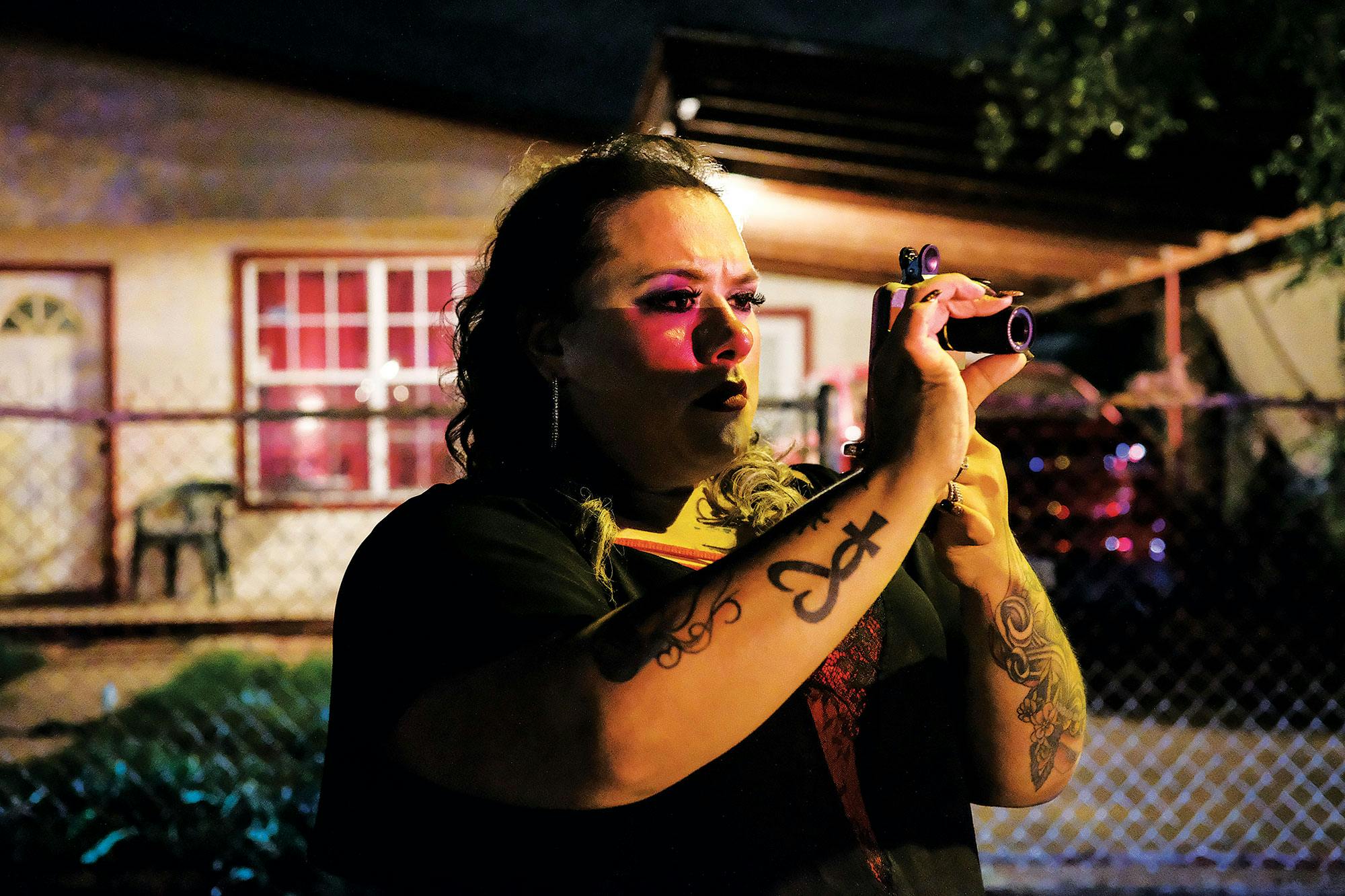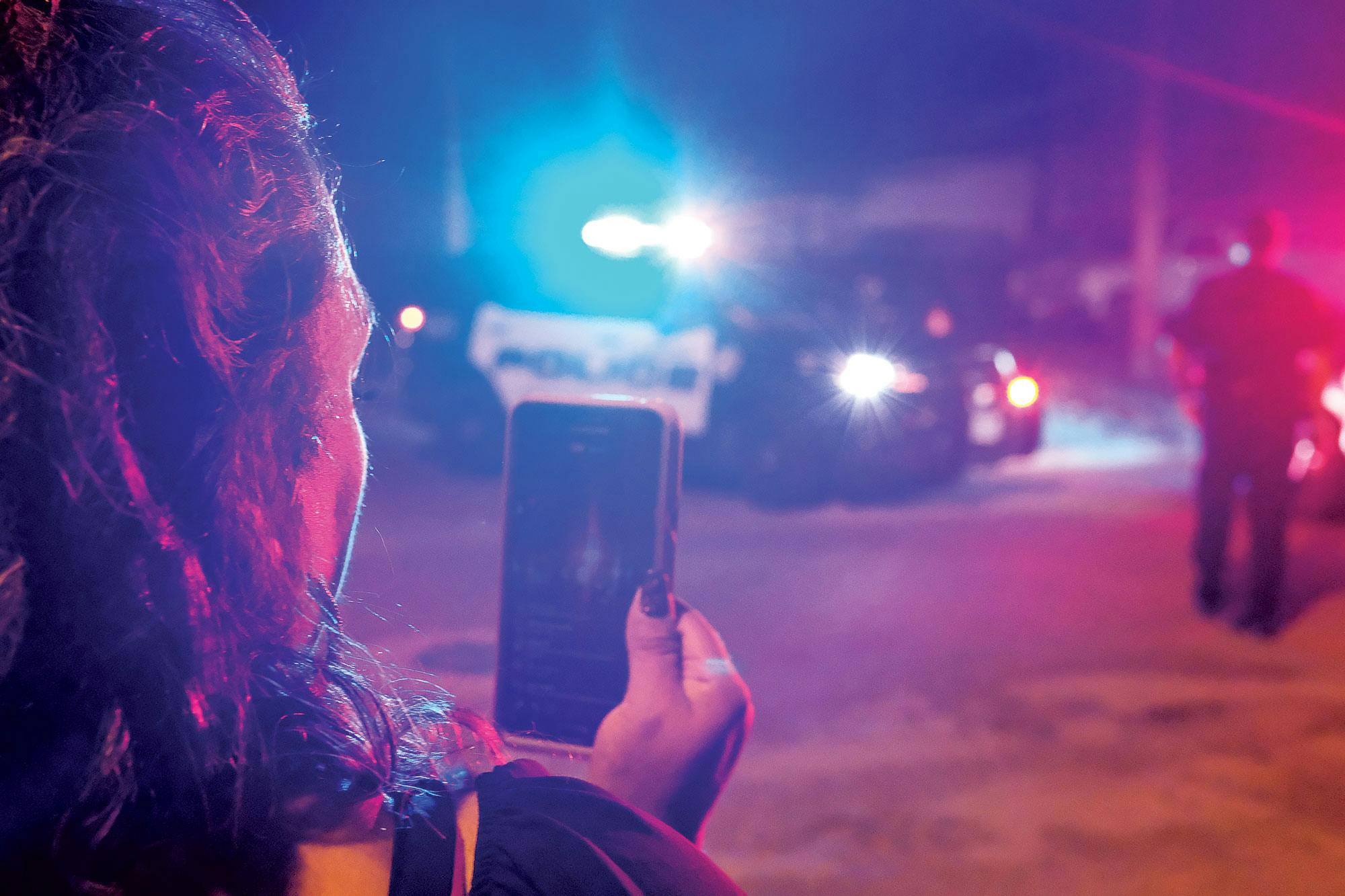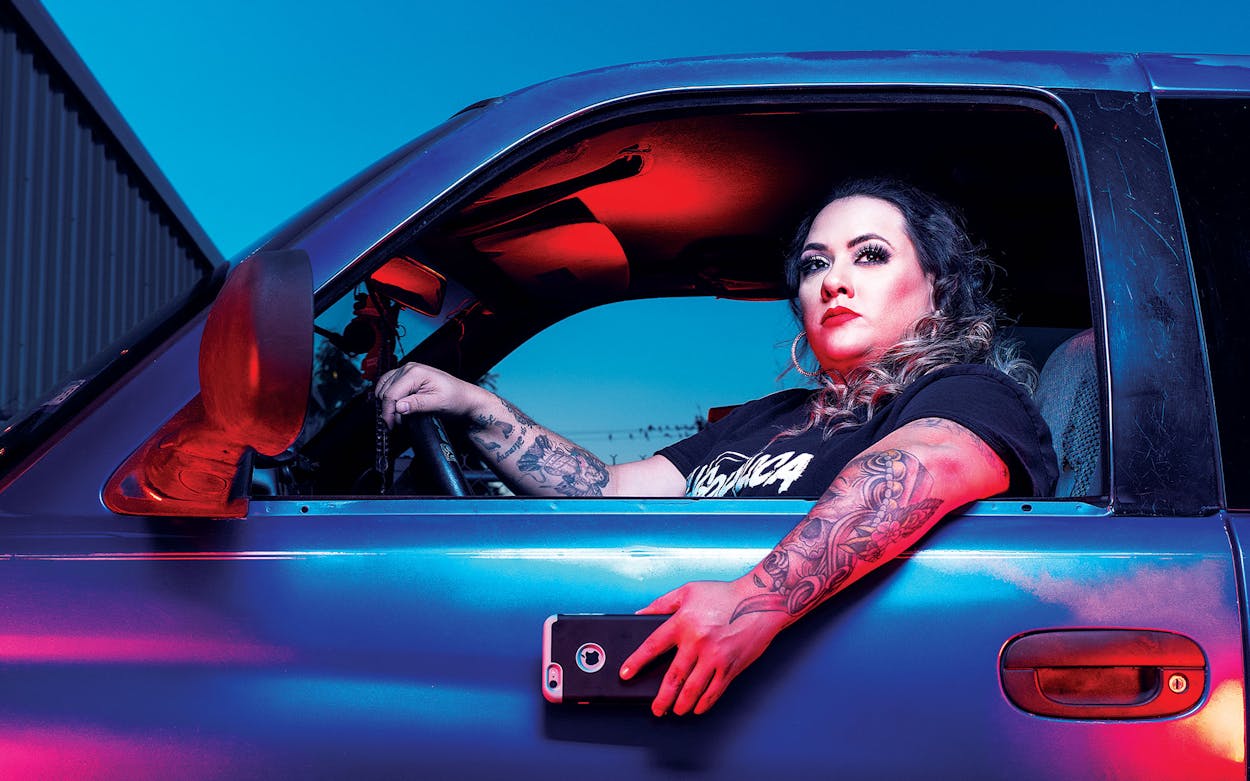Not long after the sun went down one evening in October, Priscilla Villarreal finally had the chance to sit down with a plate of food. She was in downtown Laredo, attending a friend’s daughter’s quinceañera. She glanced at her phone. Villarreal, who is 32, was well-dressed, in a black blouse and black pants. Her long hair was done in curls, and she wore bright red lipstick. She looked down at her phone again. The party hummed around her. Suddenly, the phone’s text messaging app buzzed. Someone had sent her a tip: a large police presence was gathering in the nearby Las Cruces neighborhood.
Villarreal stood up. She said a few goodbyes and rushed out to her car, a 2005 Hyundai Tiburon, blacked out with fiery orange trim, which she affectionately calls the Night Rider. She kicked off her four-inch silver heels, jumped in the car, and sped away. The Night Rider darted through central Laredo below a full moon, racing by street lamps that cast her face in soft yellow patches and pitch-black shadows. This was her first call of the night, and Villarreal was now operating as Lagordiloca, the name that her legion of fans—and critics—call her. Nearly every night, from five in the evening until five in the morning, Lagordiloca cruises the streets of Laredo in her Night Rider or a Dodge 4×4 truck she calls the Blue Demon, waiting for a phone call, a text, any kind of tip that points her toward trouble. “At night, you can expect just about everything,” she said.
Lagordiloca doesn’t work for the local newspaper or any of Laredo’s four television newscasts. She has no experience as a professional journalist and no college education. She’s a high school dropout who narrowly avoided a life behind bars. Yet in the past two years she’s become one of the most relied-upon and most viewed news sources in Laredo. She live-streams raw footage from local crime scenes—shootings, gruesome traffic accidents, tense hostage situations, immigration raids, and whatever else she comes across—to more than 80,000 loyal Facebook followers. Her video is unedited and uncensored, self-narrated in Spanish, often littered with expletives. She’s both beloved and despised for broadcasting the kinds of images that don’t make it into the city’s traditional media.
“A lot of people have messaged me thanking me for what I do, and a lot of people have messaged me pissed off because I showed a certain clip,” Villarreal said. “In the two years that I’ve been Lagordiloca, I’ve learned some lessons, what to show and not to show. But people need to know what happened.”
A few minutes after leaving the quinceañera, she arrived at the scene her tipster had told her about. A man had been shot. Las Cruces’s small homes and overgrown yards were bathed in the police cruisers’ flashing blue and red lights, and officers were scanning the pavement for bullet casings. Lagordiloca took out her phone, opened up Facebook Live, and hit record.

One afternoon in March 2015, Villarreal was napping at her home in Las Cruces, the tough, middle-class neighborhood where she grew up, a couple miles from the river. She woke up to sirens and saw police cars screaming down the street. Villarreal got in her truck and followed, and after a short drive, she found police and SWAT officers training their rifles at a house. As she walked among the large crowd that had gathered, Villarreal heard that a man was inside the house with two girls, ages six and sixteen.
She heard a volley of gunshots. The gunman had shot the two girls in the backyard before coming out front with a pistol. Officers shot and killed him in the yard. Moments later, an officer walked out of the house carrying the teenager’s limp body. Another officer carried out the younger girl, who had also been killed.
Villarreal took out her phone and hit record. She followed the officers with her camera as they loaded the bodies into an ambulance. She posted three short video clips from the scene to her Facebook page, and then she went home, cried, and took a shower. During the hours that followed, the videos went viral. They eventually topped 820,000 views. “It was just the raw video,” Villarreal said. “I was criticized for that, but I also got called by people I knew, people who saw the video. One man wanted to pay for the funerals. I had never seen so many people come together after an incident.”
At the time, Villarreal was struggling to find purpose in her life. She had sold drugs as a teenager and ended up getting busted for possession of marijuana, cocaine, and a firearm. In 2006, when she was 21, she was arrested in connection with a murder case and charged with tampering with evidence, a third-degree felony. Her attorney told her she faced twenty years in prison. But at the end of 2008, as the suspected killer’s murder trial dragged on, her charges were dismissed.
While she was waiting on the outcome of that case, she had gotten pregnant, but she lost the baby to a premature birth. The death of her daughter sent her into a deep depression, and Villarreal said she spent the next two years “basically in my house.” After her third attempted suicide, she sought help and spent a long stretch at a local mental health center. Her only source of income was a part-time job supervising a wrecker that cleaned up tractor-trailer crash sites. Villarreal would organize a crew of workers to clean up the cargo that had spilled out from a crashed trailer and move it into a new one.
After the videos of the hostage situation went viral, she kept going out to crime scenes and accidents to shoot video. She didn’t have much of a following at first, mostly people she knew from around Las Cruces. Then, two years ago, Facebook released its live-streaming service, an ideal platform for the type of video Villarreal was shooting, and her audience grew exponentially. A local radio host invited her on his show, and he said she needed a nickname. They settled on La Gordi Loca—“the Big Crazy Lady,” essentially—and it stuck.
Taking on the Lagordiloca persona was a fairly simple transition. Villarreal slept most days anyway, so the night-owl hours were routine. Soon she found that surrounding herself with gruesome scenes of death—blood-spattered pavement, cars crumpled like Coke cans—actually helped her deal with her own traumatic memories, which have taken their toll. Her hair has been falling out for years, which is why she’s often seen in public wearing bedazzled baseball caps. Her doctors tell her to slow down and sleep, but she insists that the adrenaline of the work keeps her going. “My reporting is basically my medication,” she said.
On an average week, Lagordiloca posts around a dozen videos. During the last full week of November, she posted fifteen. Those included a few advertisements for a comedy show at the Laredo Civic Center, a Happy Thanksgiving message, three car crashes—including a fatality—and a shooting. All told, her videos that week racked up 131,000 views.
Her Facebook page now has 82,000 followers. Along with a few advertisements on the page, Lagordiloca gets paid, often in free food, to post video from local restaurants looking for publicity. She sells a few Lagordiloca T-shirts and bumper stickers through Facebook, but she doesn’t make much money. She still works a few days a month with the wrecker crew, and she’s started teaching kids at a dance studio—LGL, short for Lagordiloca—that her mother recently opened.
Villarreal knows she can’t be Lagordiloca forever. She wants to eventually take a break, to take care of her health, but she doesn’t see that happening anytime soon. Right now, too many people are watching.
One afternoon in October, she got a call from a follower about a car crash. It wasn’t particularly dramatic or interesting—just parked cars and flashing lights—but within an hour, the video she streamed had eight thousand views. By then, Lagordiloca was already on the other side of town, where a police cruiser had been sideswiped by a tractor trailer.

A decade before Villarreal filmed her first video, the Knight Foundation, a news-focused nonprofit based in Florida, launched an initiative to reinvent and reenergize journalism education across the country. The foundation believed that as the traditional economic model of the industry collapsed, journalism schools needed to adapt. Most schools were, as the foundation put it, “behind the times and, in many cases, marginal players on their campuses.”
The University of Texas at Austin received one of the grants and started a course called “Journalism, Society, and the Citizen Journalist.” The goal of the course was, in part, to teach news literacy to a student population that was perceived as less engaged and more skeptical of mainstream news.
Paula Poindexter, who created and teaches the course, has done her own research into young adults and the sources they’ve turned to instead. “Citizen journalists can play a very important role,” Poindexter said. “But if someone like [Lagordiloca] is only providing news about crimes, that’s not necessarily serving the public well. There’s a place for that, but it can also give a false sense of the community.”
In many ways, Lagordiloca operates like an average citizen journalist. She records on her phone, the same as many working journalists. She publishes on Facebook, perhaps the most widely used publishing platform today. She’s even picked up a mentor of sorts, a reporter with Univision Laredo, who’s tried to show her some basics. What makes her unusual, Poindexter said, is the size of her audience and reach.
Lagordiloca is nearly as popular on social media as Laredo’s daily newspaper, which is astonishing considering that she’s a one-person operation. But, like many daily newspapers these days, the Morning Times is a shadow of its former self. An editorial staff of thirteen, including just six news reporters, covers a city of more than 257,000, which means there are inevitable gaps in coverage. Enter Lagordiloca. She can instantaneously deliver her version of the news to thousands of people on their laptops or handheld devices. Whether her videos are well reported or high quality doesn’t matter: they’re fast, familiar, and free.
That reporting style has also made her a divisive figure, and she admits that she needs to be tighter with her facts. In late August, for example, she heard that a gas shortage would hit Laredo after Hurricane Harvey. “I went live and I told everybody, ‘Fill your tanks up, just in case we run out of gas,’ ” she said. The report spread among Lagordiloca’s fans, and people panicked. Long lines formed at gas stations around the city, and she was criticized relentlessly online. Some people even blamed her for lines at stations in San Antonio. “People went ballistic,” she said. “I shouldn’t have done that.”
As her influence has grown, Lagordiloca’s role in the community has started to shift from reporter to advocate. Her followers ask her to help find runaway kids; they understand the power of her audience. She’s raised money for funeral costs for some of the victims she’s filmed. She speaks to at-risk youth. She appears at fundraisers and helps organize charity events. Before a fundraiser for the local Crime Stoppers last year, the Morning Times noted, “Yes, even local ‘nightcrawler’ Lagordiloca will have a booth.”
But that type of work has come with a cost. In the spring of last year, a woman contacted Lagordiloca because she believed a local day care center was abusing children. Her daughter had come home with bruises on her back, and the woman wanted Lagordiloca to spread the word. She did. Parents started taking their children out of the day care, and the outcry became so loud that police investigated.
“It caused a big riot on Facebook,” said Abundio Rene Cantu, an attorney in Laredo who represented the day care center in a resulting civil suit. “[The police] didn’t find anything. The bruises were basically caused by child’s play. It was all false.”
The day care facility sued, but Villarreal never hired representation, and she didn’t show up for court. “I actually got calls from several lawyers in Laredo and San Antonio wanting to represent her,” Cantu said, “because she’s such a huge media star.”
She lost the case by default, and a judge awarded the day care center $300,000 in damages. Cantu doesn’t expect that any of the money will be paid. He added that people around town contact him for help getting videos of themselves removed from Lagordiloca’s page.
“I understand why the culture of Laredo is attracted to the type of reporting she does, but a lot of people here also want [reporting] from a credible source,” Cantu said. “I’ve tried to figure out, ‘Who is this lady? Where did she come from? How did she become what she is?’ I don’t think she had much going for her and decided to become a star using Facebook.”
And a star, of a sort, is what she’s become. One evening in October, Lagordiloca was eating at one of her favorite Mexican restaurants. She posted a few videos from her table, showing plates of carnitas, sausage, and tortillas, telling her followers they should stop by. A man walked in carrying a young girl, and he asked Lagordiloca if she’d take a photo with his daughter. The day before, while she was recording from an accident scene, a black sedan drove by slowly. A window in the backseat rolled down, and a little girl leaned out, smiling and waving, filming Lagordiloca on her phone. One fan, the local rapper Wyze Mtz, even recorded a rap about her:
Breaking news before it’s top story somewhere else.
She doesn’t sugarcoat s—, this is top shelf.
Tatted up, bad as f—, and she holds her own.
Changed her weapon from a gun to her cellphone.
First on the scene? Lagordiloca . . .
First on the scene? Lagordiloca!
Not long after Lagordiloca finished recording the shooting in Las Cruces, she headed for Planeta 80, a bar and dance club on the city’s northeast side. It was dark inside, and the smoke-filled room was cast in flashing blue strobe lights. As Lagordiloca danced her way through the club, strangers—dozens of them—stopped her to ask for a photograph.
An hour passed, and the lights turned on and the music stopped. The crowd stumbled out of the club, presumably headed home. It was two o’clock in the morning, and their long night had come to an end. But for Lagordiloca, the night had just begun. She drove off into the darkness, the Night Rider humming, in search of the next moment of mayhem.
This article originally appeared in the January 2018 issue of Texas Monthly with the headline “The Night Crawler.” Subscribe today.







